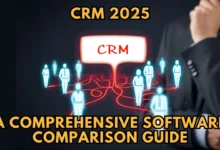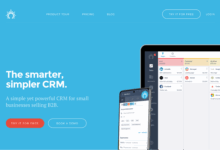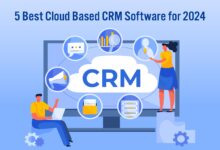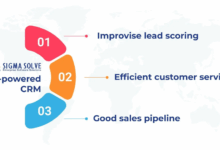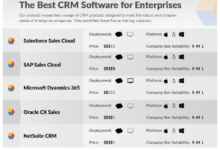CRM for Sales and Marketing Automation
CRM for Sales and Marketing Automation represents a powerful synergy, streamlining operations and boosting efficiency. By integrating sales and marketing functions within a unified platform, businesses gain valuable insights into customer behavior, leading to more targeted campaigns and improved sales conversion rates. This integration fosters collaboration, eliminating data silos and empowering teams to work more effectively together.
This exploration delves into the core functionalities of such systems, examining how they optimize sales processes, automate marketing efforts, and facilitate data-driven decision-making. We will explore best practices for implementation, data management, and measuring return on investment, ultimately demonstrating how a well-integrated CRM system can be a catalyst for substantial business growth.
Defining CRM for Sales and Marketing Automation
A Customer Relationship Management (CRM) system, when designed for both sales and marketing automation, acts as a central hub for managing all customer interactions. It streamlines processes, improves team collaboration, and ultimately drives revenue growth by providing a holistic view of the customer journey. This unified approach contrasts sharply with siloed systems, leading to increased efficiency and better data-driven decision-making.
Core Functionalities of a Sales and Marketing CRM
A comprehensive CRM for sales and marketing integrates several key functionalities. These include contact management (centralized storage and organization of customer data), lead management (tracking potential customers through the sales funnel), sales pipeline management (visualizing the progress of deals), marketing automation (automating repetitive marketing tasks like email campaigns and social media posting), reporting and analytics (providing insights into sales and marketing performance), and customer support tools (facilitating efficient communication and issue resolution). The system facilitates a seamless flow of information between sales and marketing, ensuring consistent messaging and a cohesive customer experience.
Key Differences Between Sales-Only and Integrated CRMs
CRM systems focused solely on sales typically lack the marketing automation features found in integrated systems. Sales-only CRMs primarily manage leads, track deals, and provide sales team reporting. In contrast, integrated CRMs offer broader functionalities, including email marketing, social media management, campaign tracking, and lead scoring. The marketing automation capabilities within an integrated CRM allow for targeted campaigns, personalized messaging, and automated follow-ups, leading to higher conversion rates. The integration fosters a better understanding of the customer journey, from initial contact to final sale, enabling more effective resource allocation and improved ROI.
Examples of Sales and Marketing Collaboration Using a Unified CRM
Imagine a scenario where a marketing campaign identifies a group of high-potential leads. Using a unified CRM, marketing can automatically segment these leads and pass them to the appropriate sales representatives. Sales then utilize the CRM to track interactions, manage follow-ups, and close deals. The CRM’s reporting tools enable both teams to track campaign performance, analyze sales trends, and make data-driven decisions to optimize future campaigns. Another example involves sales providing feedback on lead quality to the marketing team, enabling the marketing team to refine targeting criteria and improve campaign effectiveness. This continuous feedback loop enhances overall efficiency and results.
Comparison of Leading CRM Platforms
The following table compares three leading CRM platforms based on their sales and marketing automation capabilities. Note that features and pricing can vary based on the specific plan chosen.
| Feature | Platform A (e.g., Salesforce) | Platform B (e.g., HubSpot) | Platform C (e.g., Zoho CRM) |
|---|---|---|---|
| Contact Management | Extensive features, including custom fields and segmentation | Robust contact management with built-in marketing automation tools | Comprehensive contact management with strong reporting capabilities |
| Lead Management | Lead scoring, routing, and assignment capabilities | Advanced lead scoring and nurturing workflows | Lead capture and management tools with integration options |
| Sales Pipeline Management | Visual pipeline tracking with customizable stages | Visual pipeline management with integrated reporting | Flexible pipeline management with customizable views |
| Marketing Automation | Email marketing, campaign management, and A/B testing | Extensive marketing automation features, including workflows and landing pages | Email marketing and basic automation features with third-party integrations |
| Reporting and Analytics | Detailed sales and marketing reports and dashboards | Comprehensive reporting and analytics with custom dashboards | Robust reporting features with customizable dashboards |
Sales Process Optimization with CRM
A Customer Relationship Management (CRM) system is more than just a contact list; it’s a powerful tool for streamlining and optimizing your entire sales process. By centralizing customer information, automating tasks, and providing insightful analytics, a CRM significantly boosts sales team productivity and revenue generation. This section will explore how a well-implemented CRM can transform your sales operations.
Effective CRM utilization involves a strategic approach to managing every stage of the sales cycle, from initial lead generation to final deal closure. This includes careful lead nurturing, opportunity tracking, and sales forecasting, all facilitated by the CRM’s features. The ultimate goal is to increase sales efficiency and predictability.
Sales Workflow Design Using CRM
A typical sales workflow within a CRM system might look like this: Lead Generation (e.g., through marketing campaigns, website forms, or referrals) → Lead Qualification (assessing lead suitability) → Contact & Nurturing (engaging leads with targeted communications) → Proposal/Presentation (presenting solutions) → Negotiation (discussing terms) → Closing (finalizing the deal) → Onboarding (integrating the new client). Each stage is meticulously tracked within the CRM, providing a clear picture of the sales pipeline’s progress. For example, custom fields within the CRM can be created to track specific details like the source of the lead or the stage of negotiation. Automated email sequences can be set up to nurture leads at each stage, ensuring consistent engagement.
Best Practices for Lead Management, Opportunity Tracking, and Sales Forecasting
Effective lead management involves utilizing CRM features like lead scoring (assigning points based on lead characteristics to prioritize high-potential leads) and lead routing (automatically assigning leads to the appropriate sales representatives based on criteria such as geography or industry). Opportunity tracking involves recording all relevant details about each sales opportunity, including the potential revenue, timeline, and associated contacts. This allows for accurate sales forecasting, which is crucial for resource allocation and business planning. For instance, a sales manager can use the CRM’s forecasting tools to predict future revenue based on the current pipeline of opportunities, allowing for proactive adjustments to sales strategies.
CRM’s Role in Improving Sales Team Productivity and Efficiency
CRM systems significantly enhance sales team productivity by automating repetitive tasks such as data entry, email marketing, and reporting. This frees up valuable time for sales representatives to focus on building relationships and closing deals. Automated workflows, triggered by specific events within the CRM, can streamline processes and reduce manual effort. For example, an automated email can be sent to a customer when an order is shipped, reducing the administrative burden on sales staff. Additionally, centralized information ensures everyone on the team has access to the same data, eliminating communication silos and improving collaboration.
Sales Reporting and Analytics for Identifying Areas for Improvement
CRM systems provide robust reporting and analytics capabilities that offer valuable insights into sales performance. Sales managers can utilize these reports to identify trends, bottlenecks, and areas for improvement. For example, reports on lead conversion rates can pinpoint stages in the sales process where leads are dropping off, enabling targeted interventions. Similarly, sales representative performance can be analyzed to identify top performers and those who need additional support or training. Analyzing data on deal size and close rates can inform pricing strategies and sales techniques. This data-driven approach to sales management ensures continuous improvement and optimization of the sales process.
Marketing Automation within the CRM Ecosystem
Modern CRM platforms seamlessly integrate powerful marketing automation capabilities, significantly enhancing sales and marketing efficiency. By automating repetitive tasks and personalizing customer interactions, these systems allow businesses to nurture leads more effectively, improve conversion rates, and build stronger customer relationships. This integration streamlines workflows, providing a unified view of customer interactions across multiple channels.
Marketing automation features integrated within CRM platforms provide a centralized hub for managing and executing marketing campaigns, analyzing their performance, and refining strategies. This integration eliminates the need for disparate systems and improves data consistency, leading to more informed decision-making.
Key Marketing Automation Features Integrated within CRM Platforms
CRM systems typically incorporate a range of marketing automation features. These features are designed to automate various marketing tasks, from email campaigns to social media engagement, ultimately streamlining workflows and improving efficiency. A robust system will encompass tools for lead scoring, segmentation, campaign management, and performance analytics.
- Email Marketing: Automated email sequences, personalized email templates, A/B testing capabilities, email deliverability optimization, and reporting dashboards are standard features.
- Social Media Marketing: Social listening tools, automated posting scheduling, social media ad management integration, and social media performance analytics are commonly integrated.
- Content Marketing: Content scheduling, content performance tracking, and lead capture forms integrated with content offers are frequently included.
- Lead Scoring and Segmentation: Automated lead scoring based on pre-defined criteria and the ability to segment audiences based on various attributes are crucial features.
- Workflow Automation: The ability to create automated workflows based on specific triggers, such as website visits or form submissions, is essential for efficient lead nurturing.
Comparison of Email, Social Media, and Content Marketing Functionalities within a CRM
While all three marketing channels—email, social media, and content—contribute to a holistic marketing strategy, their functionalities within a CRM differ. Email marketing focuses on direct communication, fostering relationships through personalized messages and nurturing leads over time. Social media marketing leverages platforms like Twitter, Facebook, and LinkedIn to engage with prospects and build brand awareness. Content marketing focuses on creating and distributing valuable, relevant, and consistent content to attract and retain a clearly defined audience—and ultimately, to drive profitable customer action.
| Feature | Email Marketing | Social Media Marketing | Content Marketing |
|---|---|---|---|
| Primary Goal | Lead nurturing, conversion | Brand building, engagement | Attracting and retaining audience |
| Metrics | Open rates, click-through rates, conversions | Engagement, reach, brand mentions | Website traffic, lead generation, content downloads |
| Automation Capabilities | Automated sequences, personalized messaging | Automated posting, social listening | Content scheduling, lead capture forms |
Setting Up Automated Email Sequences for Lead Nurturing
Establishing effective automated email sequences is crucial for lead nurturing. A well-structured sequence guides prospects through the sales funnel, providing valuable information and building rapport.
- Define your target audience and their needs: Understand your ideal customer profile (ICP) and their pain points.
- Develop a series of emails: Create a sequence of emails that address specific concerns and provide relevant information. Each email should have a clear call to action.
- Segment your leads: Group leads based on their behavior and engagement to personalize messaging.
- Set up triggers and workflows: Define the triggers that initiate the email sequence (e.g., website form submission, download of a resource).
- Schedule and test your sequence: Test the email sequence thoroughly before launching it to a wider audience. Monitor key metrics to identify areas for improvement.
- Analyze and optimize: Track open rates, click-through rates, and conversions to refine your email sequence and improve performance.
Examples of Personalized Customer Interactions with CRM-Integrated Marketing Automation
CRM-integrated marketing automation enables highly personalized customer interactions. For example, a welcome email triggered by a website signup could include the user’s name and details about their specific interests based on their website activity. Further, a series of emails could then be automatically sent based on their subsequent actions, such as downloading specific content or attending a webinar. Similarly, a customer who hasn’t engaged with a company’s emails for a period of time might receive a personalized email asking if they need any assistance or have any questions. This targeted approach fosters stronger customer relationships and improves overall marketing effectiveness.
Integration and Data Management
A robust CRM system isn’t just a standalone tool; its true power lies in its ability to connect and seamlessly share information with other crucial business systems. Effective integration and meticulous data management are fundamental to maximizing the value of your CRM investment, driving efficiency, and fueling data-driven decision-making across sales and marketing. Without this integration, your data remains siloed, hindering a holistic view of your customer journey and operational performance.
Data integration between your CRM and other systems like ERP (Enterprise Resource Planning) software, e-commerce platforms, and marketing automation tools creates a unified view of your customer interactions. This holistic perspective allows for a more streamlined and efficient workflow, improved data accuracy, and ultimately, better business outcomes. By eliminating data duplication and inconsistencies, you can improve the quality of your insights and make more informed strategic choices. Imagine, for example, instantly seeing a customer’s complete purchase history from your e-commerce platform within your CRM, enriching your sales interactions and personalized marketing efforts.
Data Integration Best Practices
Maintaining data accuracy and consistency is paramount for reliable reporting and insightful analysis. This requires establishing clear data governance policies, including defining data ownership, setting data quality standards, and implementing data validation rules. Regular data cleansing and deduplication are essential to remove outdated, incorrect, or duplicate entries. Adopting a standardized data format across all integrated systems ensures seamless data flow and prevents discrepancies. Automated data synchronization processes minimize manual intervention, reducing the risk of human error and improving overall data integrity. Furthermore, investing in robust data quality monitoring tools allows for proactive identification and resolution of data issues before they impact decision-making.
Data-Driven Decision Making with CRM
A well-integrated CRM system serves as a central repository of valuable customer data, providing a wealth of insights for data-driven decision-making. By analyzing sales performance metrics, marketing campaign results, and customer behavior patterns, businesses can identify trends, optimize strategies, and improve overall efficiency. For example, analyzing customer churn data can pinpoint areas for improvement in customer service or product development. Similarly, tracking sales conversion rates can help optimize sales processes and improve lead qualification. This data-driven approach enables proactive adjustments, leading to more effective sales and marketing campaigns and ultimately, increased revenue.
Challenges of Data Migration and Integration
Effective data migration and integration can present several challenges. Addressing these proactively is crucial for a smooth transition and the successful implementation of a CRM system.
- Data Inconsistency and Duplication: Different systems may use varying data formats and definitions, leading to inconsistencies and duplicate records. Solution: Implement data cleansing and deduplication processes before migration, and establish standardized data formats across all systems.
- Data Mapping Complexity: Mapping data fields between different systems can be complex, especially with large datasets. Solution: Utilize data mapping tools and establish a clear mapping strategy to ensure accurate data transfer.
- Integration Complexity: Integrating multiple systems requires technical expertise and can be time-consuming and costly. Solution: Choose a CRM system with robust integration capabilities and consider engaging experienced IT professionals.
- Data Security Concerns: Transferring sensitive customer data requires stringent security measures to protect against data breaches. Solution: Implement robust security protocols, including encryption and access controls, throughout the integration process.
- Data Migration Time and Resources: Migrating large datasets can be time-consuming and resource-intensive. Solution: Plan the migration carefully, including a phased approach if necessary, and allocate sufficient time and resources.
Measuring ROI and Key Performance Indicators (KPIs)
Implementing a CRM system represents a significant investment, demanding a robust strategy for evaluating its effectiveness and justifying continued resource allocation. Understanding key performance indicators (KPIs) and employing effective methods for tracking return on investment (ROI) are crucial for demonstrating the value of the CRM to stakeholders and ensuring its ongoing success.
The successful measurement of a CRM’s impact hinges on identifying the right KPIs and employing appropriate tracking methods. This involves aligning specific metrics with overall business objectives, ensuring that data collected is relevant, accurate, and readily accessible for analysis. Failing to establish a clear framework for measuring ROI can lead to difficulty in demonstrating the system’s value and securing future funding.
Key Performance Indicators for Sales and Marketing
Effective CRM implementation requires a multifaceted approach to KPI tracking, encompassing both sales and marketing activities. Focusing on a limited set of key metrics ensures that efforts are concentrated on the most impactful areas. These KPIs provide insights into the efficiency and effectiveness of sales and marketing operations, guiding future strategic decisions.
- Lead Conversion Rate: This metric measures the percentage of leads that progress through the sales funnel and convert into paying customers. A high conversion rate indicates effective lead nurturing and sales processes. For example, a conversion rate of 20% suggests that for every 5 leads generated, one converts into a paying customer.
- Customer Acquisition Cost (CAC): This KPI represents the total cost of acquiring a new customer. A lower CAC is desirable, reflecting efficient marketing and sales efforts. Tracking CAC over time can highlight areas for improvement in resource allocation.
- Customer Lifetime Value (CLTV): This metric calculates the total revenue generated by a customer over their relationship with the company. A high CLTV demonstrates the long-term value of customer retention strategies. For instance, a CLTV of $10,000 indicates that, on average, each customer generates $10,000 in revenue throughout their engagement.
- Sales Cycle Length: This KPI measures the time it takes to close a deal, from initial contact to final sale. Reducing sales cycle length improves sales efficiency and increases revenue. For example, a reduction in sales cycle length from 30 days to 20 days represents a 33% improvement in efficiency.
- Marketing Qualified Leads (MQLs) and Sales Qualified Leads (SQLs): These metrics track the number of leads generated through marketing efforts that meet specific criteria (MQLs) and the subset of those leads deemed ready for sales engagement (SQLs). A high ratio of SQLs to MQLs suggests effective lead qualification processes.
Measuring Return on Investment (ROI)
Calculating the ROI of a CRM implementation requires a comprehensive approach that considers both the costs and benefits associated with the system. This involves carefully tracking expenses related to software licenses, implementation, training, and ongoing maintenance. Simultaneously, it is essential to quantify the positive impacts of the CRM on key business metrics.
ROI = (Gain from Investment – Cost of Investment) / Cost of Investment
For example, if the CRM implementation cost $10,000 and generated an additional $50,000 in revenue within the first year, the ROI would be 400%. This calculation demonstrates a substantial return on the initial investment.
CRM Dashboards and Reports
Modern CRM systems offer robust reporting and dashboarding capabilities, enabling users to visualize key KPIs and track performance over time. Dashboards provide a high-level overview of key metrics, while detailed reports offer deeper insights into specific areas of performance.
A typical sales dashboard might display metrics such as daily/weekly sales figures, conversion rates, average deal size, and sales cycle length. A marketing dashboard could showcase metrics such as website traffic, lead generation numbers, email open rates, and campaign ROI. Customizable reports can be generated to drill down into specific aspects of performance, such as individual sales representative productivity or the effectiveness of specific marketing campaigns.
Using CRM Data to Justify Budget Allocation
The data collected and analyzed within a CRM system provides a strong foundation for justifying budget requests for future sales and marketing initiatives. By demonstrating a clear link between investments and resulting improvements in KPIs, businesses can effectively advocate for increased resource allocation.
For instance, data showing a significant increase in lead conversion rates following a specific marketing campaign can be used to justify increased budget for similar campaigns in the future. Similarly, data indicating a reduction in sales cycle length after implementing a new sales process can be used to advocate for further investment in sales training and process optimization. By presenting concrete evidence of the CRM’s positive impact, businesses can secure the necessary resources to continue driving growth and success.
Future Trends in CRM for Sales and Marketing Automation
The landscape of Customer Relationship Management (CRM) is rapidly evolving, driven by advancements in technology and shifting customer expectations. The integration of artificial intelligence (AI) and machine learning (ML) is transforming how businesses interact with their customers, leading to more personalized experiences and efficient operations. This section explores these emerging trends and their impact on sales and marketing processes.
The Impact of AI and Machine Learning on CRM
AI and ML are revolutionizing CRM systems, enabling predictive analytics, automated workflows, and personalized customer interactions. AI-powered chatbots provide instant customer support, freeing up human agents to focus on complex issues. Machine learning algorithms analyze vast datasets to identify sales patterns, predict customer churn, and personalize marketing campaigns. For example, a CRM system using ML could predict which leads are most likely to convert into paying customers, allowing sales teams to prioritize their efforts effectively. This targeted approach improves conversion rates and reduces wasted resources. Furthermore, AI can automate repetitive tasks such as data entry and lead qualification, freeing up valuable time for sales and marketing teams to focus on strategic initiatives.
Adapting to Changing Customer Expectations and Behaviors
Modern customers expect seamless, personalized experiences across all touchpoints. They demand immediate responses, relevant information, and consistent brand messaging. CRM systems are adapting to meet these expectations by integrating various channels, including social media, email, and mobile applications. For example, a CRM system might track customer interactions across multiple channels, providing a unified view of the customer journey. This holistic view enables businesses to offer more personalized recommendations and targeted marketing messages. The increased use of omnichannel strategies directly reflects this adaptation; companies are leveraging CRM to manage customer interactions across various platforms, ensuring consistency and personalization.
A Hypothetical Future CRM System
Imagine a future CRM system that seamlessly integrates AI-powered predictive analytics, augmented reality (AR) tools, and blockchain technology. This system would not only predict customer behavior but also proactively anticipate their needs. AR features could enable sales representatives to visualize product placements in a customer’s environment, enhancing the sales process. Blockchain technology could ensure secure and transparent data management, enhancing customer trust and data integrity. This system would learn and adapt continuously, becoming more intelligent and efficient over time, proactively suggesting personalized marketing campaigns based on real-time customer interactions and predicted future behaviors. The system would also automatically flag potential compliance issues and ensure data privacy regulations are met. This level of sophistication would represent a significant leap forward in CRM capabilities, fundamentally changing how businesses manage customer relationships.
Closure
Ultimately, effective CRM for Sales and Marketing Automation hinges on strategic implementation and a commitment to data-driven decision-making. By leveraging the insights gleaned from integrated data and automated processes, businesses can refine their sales strategies, personalize customer interactions, and ultimately achieve a significant return on their investment. The future of CRM continues to evolve with the integration of AI and machine learning, promising even greater efficiencies and insights in the years to come.
